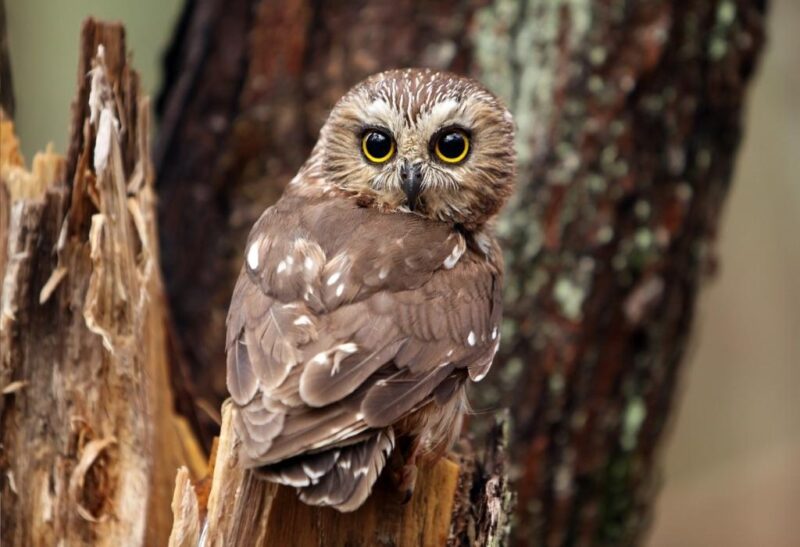Owls are among the most mysterious birds in the world. Aside from being rarely seen in the day, they also fly in complete silence.
The most possible way of knowing that they are around is when you hear them hooting at night. If you are in New Jersey, you may wonder, “Are there owls here in New Jersey?” And they do exist.
What are the owl species in New Jersey? The owl species that live in New Jersey are the Barred owl, Barn owl, Eastern Screech owl, Great Horned owl, Long-eared owl, Northern Saw-whet owl, Short-eared owl, and Snowy owl. Not all of them are permanent residents of the state. Some of them are winter visitors.
Some cultures have associated owls with myths and legends. In some countries, people treat them as a sign of death, which is not true. Despite their huge eyes, owls have very interesting characteristics.
In this comprehensive guide, you will learn everything you should know about owls in New Jersey.
Table of Contents
What Time of the Day Owls Are Most Active?
Owls are known for being nocturnal birds, which means they are most active at night. Nevertheless, some species, such as northern hawk owls, are diurnal and are active throughout the day.
They are most active in the early morning and late evening. Short-eared owls are also diurnal birds but to a much lesser extent.
Where Do Owls Go During the Day?
Most owl species rest during the day after spending the night hunting. They go back to their nest, which are usually tree cavities or hollows. Some owls prefer to sleep alone in their nests, while some share it with others.
Most owls don’t build nests. Instead, they use empty nests built by other birds, such as woodpeckers.
How Many Owls Are in New Jersey?
There are around 18 owl species in North America, and eight of them are found in New Jersey. Five of them live permanently in the state.
They are the barn, barred, eastern screech, great horned, and the northern saw-whet owls. The long-eared, short-eared, and snowy owls are from other North American states.
What Is the Most Common Owl in New Jersey?
So far, the most common owl in New Jersey is the Eastern Screech owl. These non-migrating owls are seen in the state all year round. Breeding season is usually from mid-March to mid-May.
When winter arrives, some owl species migrate from the north and south to the Garden State in search of food.
What Kind of Owls Are Native to New Jersey?
There are no records showing which owls are native to New Jersey. But then, the owl species that are permanent residents in the state are the eastern screech-owls, great horned owls, barred owls, barn owls, and short-eared owls.
However, some of them already have a declining population due to various human activities.
8 Owls Species in New Jersey: Identification and Characteristics
1. Eastern Screech Owl
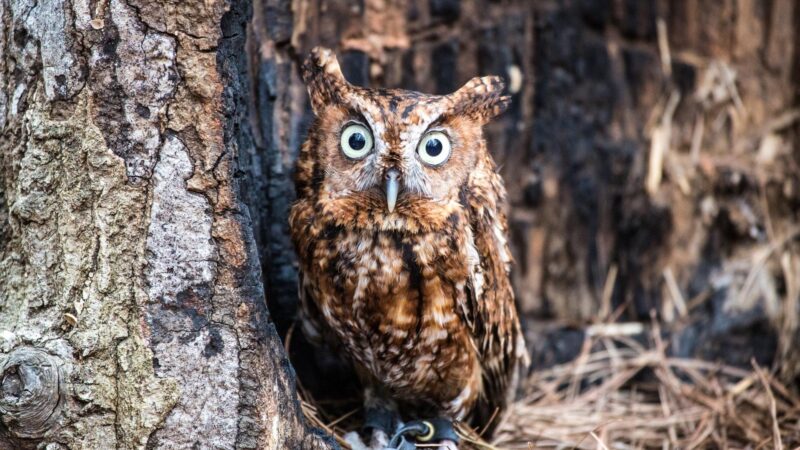
What Are Eastern Screech Owls?
Scientifically known as Otus asio, the Eastern Screech owl is one of the most common owls in North America and Southern Canada. Interestingly, it is the most common breeding owl in New Jersey.
They got their name for the high-pitch sound they use for courting and warning others of potential danger.
What Do Eastern Screech Owls Look Like?
Eastern screech owls come in two colors – gray and red-brown. But being a master of disguise, they can change their color to blend with tree bark. This is to hide from predators such as hawks and larger owls.
Both sexes have yellow eyes and beaks, bold streaks on their breasts, big feet, and feathered toes.
Eastern Screech owls have small symmetrical ears, which appear to be big due to the large feather tufts on either side. Adults are quite smaller than other owl species.
They are only 16 to 25 cm (6.2 to 9.8 inches) long and weigh 121 to 244 grams. But as usual, female Eastern Screech owls are bigger than males.
Where Do Eastern Screech Owls Live?
Eastern Screech owls live in any kind of habitat, but mostly in an elevation about 1500 meters and below. These birds are found in boreal forests or wooded areas, but they can also survive well in urban and suburban areas, close to humans. They nest in tree cavities, bird nests, and even man-made nests.
What Do Eastern Screech Owls Eat?
Eastern Screech owls are generally not picky eaters. They eat earthworms, small amphibians, flying insects, reptiles, and birds, as well as rodents such as bats, mice, and voles.
To catch prey, these opportunistic hunters usually hunt during the first four hours of darkness and hover to catch prey from perches.
How Long Do Eastern Screech Owls Live?
In captivity, Eastern Screech owls can live for more than 20 years. But in the wild, their lifespan is reduced to about 14 years and 2 months. During their first year of life, only 30-50% may survive.
In most cases, they live in pairs for life. If the male happens to have a second female, the first one will be evicted.
2. Great Horned Owl
What Are Great Horned Owls?
Scientifically known as Bubo virginianus, the great horned owl is famous for being the largest tufted owl in North America. They are widely distributed from North to South America.
It is also known for being one of the most impressive owls in New Jersey. Great horned owls are solitary birds and do not migrate.
What Do Great Horned Owls Look Like?
Like most owl species, Great Horned owls have round faces and large, face-forwarding, yellow eyes. However, they can be distinguished with their unique horn-like feather tufts on top of their head and a white patch around their throat. These large owls vary in color, from reddish-brown to black and white to gray.
Great Horned owls have an overall length of 18 to 25 inches (45.7 to 63.5 cm), with a wingspan of 50 to 60 inches (127 to 152.4 cm.)
Females have an average weight of 1.7 kg, while males have only an average weight of 1.3 kg. Species in the northern regions are significantly bigger than those in the southern regions.
Where Do Great Horned Owls Live?
Known for their deep-pitched hooting sound, Great Horned owls live from sea level to about 3352.8 meters high. They are mostly found in swamps, deserts, grasslands, and open fields.
However, these birds may occasionally live in residential and industrial areas. Hence, you may sometimes see them in parks.
What Do Great Horned Owls Eat?
Great Horned owls are carnivores and feed on an extremely wide variety of prey, especially terrestrial vertebrates. This includes lagomorphs, rabbits, rats, skunks, squirrels, and voles.
But once these voracious raptors are near the water, they may also eat fish, amphibians, crustaceans, reptiles, scorpions, and insects.
How Long Do Great Horned Owls Live?
Great Horned owls have an average lifespan of 13 years. In the wild, the oldest great horned owls were recorded to have lived for 28 years.
In captivity, their life span is from 20 to 30 years, and the longest lifespan that was put on record is 35 years. Reducing their habitat and other human activities affects their life span.
3. Barred Owl
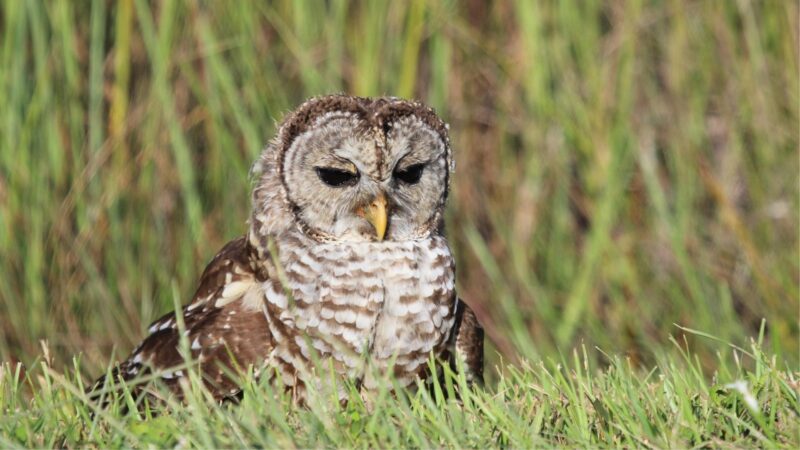
What Are Barred Owls?
Scientifically known as Strix varia, the Barred owl is closely related to the Great Horned Owl. It can be found in the United States and has extended to Canada and Mexico.
As non-migrating birds, barred owls are common in several states, including Florida, Maryland, Michigan, New Jersey, Oregon, and Washington.
What Do Barred Owls Look Like?
As the name implies, Barred owls have alternate bands of different colors. Their head, chest, and back are gray-brown with buff-white edges, while their neck and upper portion of the breast have transverse barring.
These stunning, striped owls also have barred wings and lengthwise or vertical brown streaks on their belly.
Barred owls also have a yellow bill and dark brown eyes but no ear tufts. Males are about 48 cm (19 inches) long and have an average weight of 630 grams.
On the other hand, females are about 48 cm (19 inches) long and weigh approximately 800 grams. Both sexes have a wingspan from 107 to 111 cm (42 to 44 inches).
Where Do Barred Owls Live?
Barred owls live in mature and coniferous forests with large tree branches where they can perch. These loud-screaming owls also love to stay in wooded swamps or trees near a water source.
They use huge tree cavities as nests for their young. Barred owls prefer living in isolation rather than being close to humans.
What Do Barred Owls Eat?
Like most owl species, Barred owls eat small mammals, including rabbits, rats, short-tailed shrews, and white-footed mice. They also feed on fish, amphibians, and reptiles.
When hunting for prey, barred owls move their head up and down (bobbing motion), which helps them estimate the distance of the prey from them.
How Long Do Barred Owls Live?
In captivity, their average lifespan is 23 years. In the wild, Barred owls can live for 10 years or more. The oldest known barred owls in the wild were 18 years and 2 months old.
Most deaths occur in their first year of existence and are said to be due to hunting and roadkill. Great horned owls are their only predator.
4. Northern Saw-Whet Owl

What Are Northern Saw-Whet Owls?
Scientifically known as Aegolius acadicus, the Northern Saw-whet is the smallest owl in New Jersey but is not commonly seen in the state.
It can only be found in North America, including Alaska, Canada, Mexico, and West Virginia, especially during winter. Saw-whet owls are migrating birds and are highly nocturnal.
What Do Saw-Whet Owls Look Like?
Northern Saw-whet owls have mottled brown bodies, huge, reddish-brown to brown heads, white facial discs, and bright yellow eyes. They also have a white speckled neck and dark-colored bills.
Their abdomen has white streaks, while their legs and feet are heavily covered with feathers to help them survive the winter cold.
Male Saw-whet owls are 18 to 20 cm (7 to 7.9 inches) long, while females are 20 to 21.5 cm (7.9 to 8.5 inches long). The average body weight of males and females is 75 and 100 grams, respectively.
Adults can have a wingspan of 45 to 60 cm (15.7 to 23.6 inches). The younger ones are chocolate-brown, though.
Where Do Saw-Whet Owls Live?
Northern Saw-whet owls live in all kinds of forests and woodlands but are most commonly found in coniferous forests. They also require dense vegetation for roosting and perches for hunting.
Despite being very secretive birds, they may also live in rural and suburban environments but will prefer high elevations.
What Do Saw-Whet Owls Eat?
Like most owls, Northern Saw-whet owls are carnivores and mainly eat small mammals such as rodents. These owls also eat large insects and small birds, such as sparrows and swallows.
As nocturnal predators with highly developed ears, saw-whet owls can hunt prey from a low perch in complete darkness.
How Long Do Saw-Whet Owls Live?
In the wild, Northern Saw-whet owls have lived up to 7 years. Among their natural predators are barred owls, great horned owls, and long-eared owls. In human care, healthy birds can live for as long as 16 years.
However, the average lifespan of northern saw-whet owls in captivity is about 124 months (10.3 years).
5. Long-Eared Owl

What Are Long-Eared Owls?
Bearing the scientific name Asio otus, the Long-eared owl is found throughout North America and Europe, particularly in temperate regions. It is now rare in New Jersey and is considered endangered species in the state.
The main reason is habitat reduction due to the conversion of softwood forests to hardwood forests.
What Do Long-Eared Owls Look Like?
The Long-eared owl got its name due to its long ear tufts (cluster of feathers) on top of the head. Its true ears are located on both sides of the head.
When perched, long-eared owls can look like tree limbs by compressing their feathers and extending their body and ear tufts. This protects them from predators.
Female Long-eared owls are 27-40 cm (10.6-15.7 inches) long and weigh 260-435 grams. Males are 35-37.5 cm (13.7-14.7 inches) long and weigh 220-305 grams.
Also called cat owls, adult Long-eared owls have brownish-gray feathers with vertical streaks and a wingspan of 90 to 100 cm (35 to 39 inches).
Where Do Long-Eared Owls Live?
Long-eared owls live in open areas such as farms, parks, marshes, and yards near dense stands of evergreens. They require high densities of foliage for their nests and roosting sites.
Aside from predators, this also protects them from cold temperatures. They prefer using abandoned nests instead of making new ones.
What Do Long-Eared Owls Eat?
Long-eared owls primarily feed on small mammals such as deer mice, kangaroo rats, pocket gophers, rabbits, shrews, and voles.
Since these actively-nocturnal owls have asymmetrical ears, they have a superb sense of locating prey. No wonder they can also catch small flying birds and bats even in total darkness.
How Long Do Long-Eared Owls Live?
The average lifespan of Long-eared owls is 11 years (133 months), but they can live for 10 to 30 years. In the wild, the oldest long-eared owl on record is 27 years and 9 months old.
In Germany and Switzerland, their annual survivorship is only 69%. Nestlings of these strictly-nocturnal owls are often killed by raccoons.
6. Short-Eared Owl
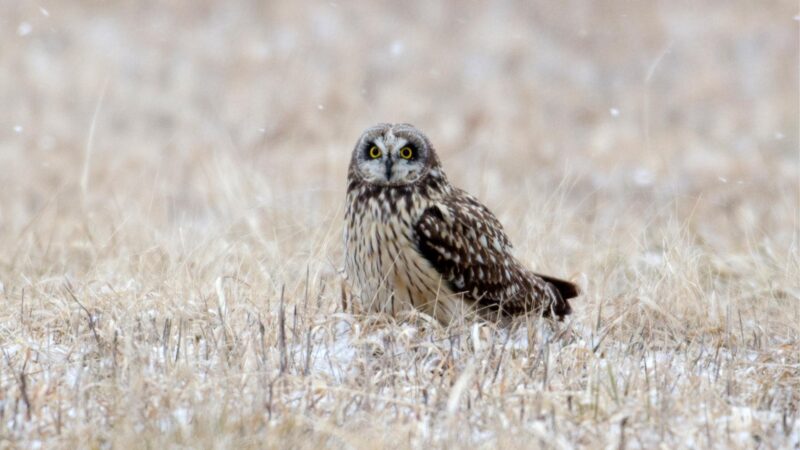
What Are Short-Eared Owls?
Scientifically known as Asio flammeus, the Short-eared owl is found on every continent, including North America, except Australia and Antarctica.
However, it is considered endangered species in some states such as New Jersey, New York, and Pennsylvania. Short-eared owls are close relatives of long-eared owls.
What Do Short-Eared Owls Look Like?
As the name implies, Short-eared owls have short ear tufts. They also have a black beak, a round, white facial disk, and yellow eyes.
Colors vary in individuals, but males are usually dark brown and yellow-white, while their chests are buff-colored with brown streaks. Females are slightly bigger and have darker colors.
Female Short-eared owls are 340-423 mm (13.4-16.7 inches) long and weigh 280-500 grams. Males are 340 to 415 mm (13.4-16.3 inches) long and weigh 200-450 grams.
Both sexes have a wing span of 950 to 1100 mm (37.4 to 43.3 inches). Like Long-eared owls, Short-eared owls also have asymmetrical ears.
Where Do Short-Eared Owls Live?
Unlike most owl species, Short-eared owls build their nests on the ground and relatively flat lands. They live in open, treeless areas, dry marshes, meadows, woodlands, and even in reclaimed mines.
Short-eared owls migrate within short to medium distances during summer and winter but will still choose similar habitats.
What Do Short-Eared Owls Eat?
Short-eared owls mostly feed on small mammals, including bats, gophers, deer mice, rabbits, rats, moles, weasels, and voles. Sometimes, they also eat small birds.
As compared to other owls, short-eared owls can be crepuscular, diurnal, and nocturnal. During the daytime, you may see them flying low to hunt for prey.
How Long Do Short-Eared Owls Live?
In captivity, Short-eared owls can live for 12 years. There is no record of their average lifespan in the wild, but the oldest wild Short-eared owl has lived for only 4 years and 2 months.
The most probable cause of their mortality is their low-flying behavior. They are prone to be hit by cars and are vulnerable to predators.
7. Barn Owl
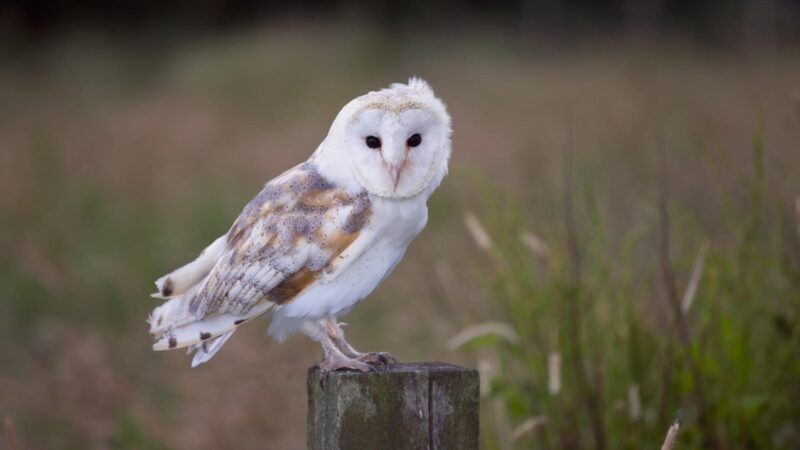
What Are Barn Owls?
The scientific name of the barn owl is Tyto alba, wherein “tyto” in Greek means “owl” and alba” means “white.” They are widely distributed on all continents, except Antarctica.
These cosmopolitan owls are seen all year round in both rural and urban environments. However, they are not very common in New Jersey.
What Do Barn Owls Look Like?
Barn owls are referred to as sweetheart owls because of their heart-shaped face. Their white face, body, and tail have a brown outline, while their eyes are dark and huge.
Their head and back are covered with light brown feathers, with some black and white spots. But unlike many owl species, barn owls have no ear tufts.
Female Barn owls are slightly longer and much heavier than males. They are 34-40 cm (13-16 inches) long and weigh about 570 grams, while males are only 32-38 cm (12-15 inches) long and weigh about 470 grams.
Barn owls have broad, rounded wings and a wingspan range of 107-110 cm (42-43 inches).
Where Do Barn Owls Live?
Barn owls are adaptable to a wide range of habitats, including tropical and temperate regions. They usually live at low elevations such as agricultural fields, deserts, grasslands, and riverbanks.
While in cities, barn owls live near the human habitat, including abandoned buildings, barns, and other man-made structures.
What Do Barn Owls Eat?
Barn owls eat small mammals such as gophers, muskrats, mice, rats, rabbits, shrews, and voles. They may also eat insects, small birds, and reptiles.
The owls use their powerful sense of sight and hearing to catch prey. Barn owls swallow prey whole but don’t eat fur. For huge prey, they break them down into pieces.
How Long Do Barn Owls Live?
Wild barn owls are known for having a short life span. They have an average life span of 20 months. During their first year of life, the mortality rate can be up to 75%, and the most common cause of death is starvation.
The longest recorded lifespan of a barn owl in the wild is 34 years. In captivity, they can live for 15 years.
8. Snowy Owl
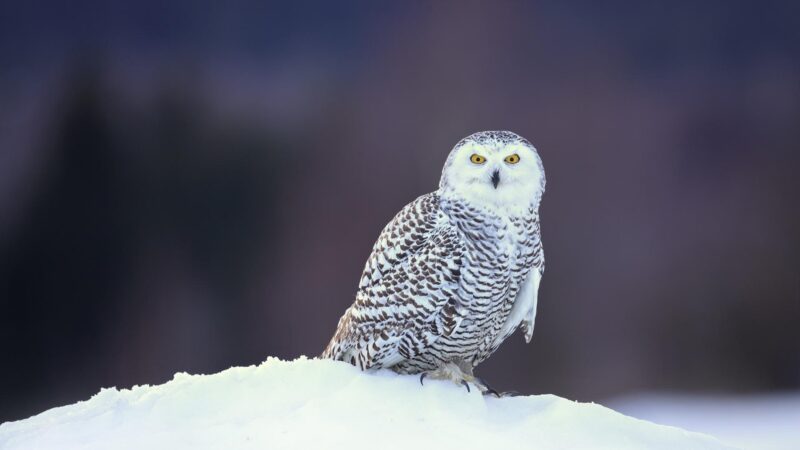
What Are Snowy Owls?
With a scientific name of Nyctea scandiaca, the Snowy owl is a native of the tundra (treeless regions) in the Arctic. They also breed in Alaska, Canada, Greenland, and Russia.
Despite having no specific pattern in terms of migration, snowy owls occasionally visit the Jersey Shore, particularly during winter.
What Do Snowy Owls Look Like?
As the name suggests, Snowy owls have thick feathers on their body, legs, and feet. These feathers are predominantly white but have dusky brown spots, except on their face.
They have bright yellow eyes and black beaks but no feather tufts. Males tend to be almost pure white, while females have more dark markings.
Being the largest bird species in the Arctic region, Snowy owls are 63-73 cm (25-29 inches) long and have an average wingspan of 170 cm (67 inches or 5.5 feet).
They are also one of the heaviest owl species in North America. Females weigh between 1550 and 1600 grams, while males weigh 1450 to 1500 grams.
Where Do Snowy Owls Live?
Snowy owls live in open tundra, usually from sea level to 300 meters high. Although these majestic birds spend summer in the Artic, they can also be seen in villages and urbanized environments, during non-breeding seasons, and if food is scarce. But then, they try to avoid living in trees and away from humans.
What Do Snowy Owls Eat?
As sit-and-wait carnivores, Snowy owls can swivel their head at around 270 degrees while on an elevated perch. Their main diet includes lemmings, mice, and arctic hares.
But given a chance, they will also eat rabbits, fish, ducks, and sea birds. Amazingly, even males also bring home some food for their young.
How Long Do Snowy Owls Live?
In the wild, Snowy owls have a lifespan of 9-10 years. The oldest known snowy owl in the wild has lived for 9 years and 5 months. In captivity, these territorial owls can live for 20-25 years.
The oldest recorded snowy owl in captivity has lived for 28 years. Sad to say, climate change has a very strong impact on their population.
Summary
Keeping migratory birds such as owls as pets is illegal in the United States. You need approval from the Department of Interior U.S. Fish and Wildlife Service. You are also not allowed to keep some of their feathers.
But if you are in New Jersey, spotting them is not uncommon. It’s better though if you have binoculars.
List of Sources
Bachynski, K., Harris, M. S. (2002). Tyto alba. Animal Diversity Web.
Dewey, T., McDonald, S. (1999). Otus asio. Animal Diversity Web.
Dietrich, D. (2013). Bubo virginianus. Animal Diversity Web.
Yan, J. (2001). Aegolius acadicus. Animal Diversity Web.
Kling, A. (2021). Woodland Wildlife Spotlight: Great Horned Owl. University of Maryland Extension.
